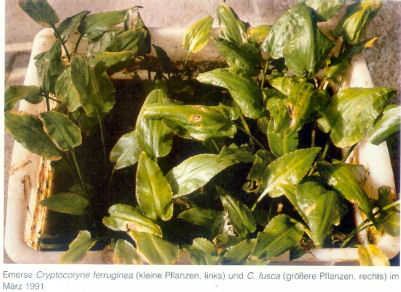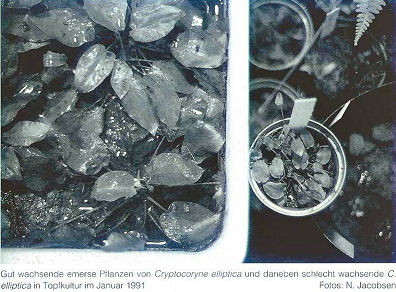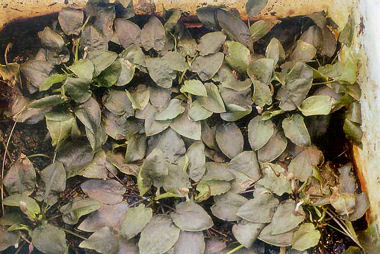|
|||||

|
|
|
 |
Niels Jacobsen, Copenhagen
|

ap17_18_p.jpg big |
I have been cultivating Cryptocoryne species some 20 years now and can look back on many nice hours of work and study, the reward being when a plant flowered for the first time and its identity was revealed. Looking back I can recall having seen most of the cultivated species in flower, but then, admittedly, I have had access to greenhouses. Also it must be said that I have had many plants that have not survived my various experiments. |

ap17_19_p.jpg big |
There has been a number of species that I have not been able to cultivate in such a way that you could say that I really had them under control, i.e. make them grow like they grow in the rain forest and make them flower when I wanted them to do so or at least during the yearly flowering season. These were the species from the lowland, tropical rain forests of Malaysia and Indonesia, actually numbering quite many. I have from time to time had them in flower, and a number of plants have flowered many times, but the plants did not grow satisfac¬torily for prolonged periods of time, and their size was not what I could want. All kinds of methods and tricks were tried, but in the long run I could not produce stable conditions for these species and maintain large growths. Jan Bastmeijer has had better success with a number of them grown emerged in peat in pots. |

ap17_20_p.jpg big |
The submerged growth in aquaria has been, and still is a problem with a number of these species. I have seen some big and regularly flowering, submerged plants of C. cordata and C. purpurea in the water Lilly basin in the Botanical Garden in Copenhagen. Here they grew in the big tub where Nelumbo, The Sacred Indian Lotus, was planted in a mixture of soil, sand, and peat. I have tried to copy these conditions but without the success of the Nelumbo tub. |

ap17_21_p.jpg big |
I have seen these Cryptocoryne species grow in the rivers in southeast Asia and have spent many hours trying to find a method that would duplicate the tropical rain forest condi¬tions and still be suitable for aquarium-like circumstances, but with only limited success. I have tried soft water, acid water, nutrients, iron, a whole number of soil types including peat, different light types, shade, sunlight, and many, many other things. I have tried to put dead leaves from the trees in the greenhouses in the tanks, but also without success. |

ap17_22_p.jpg big |
One day when I once again was thinking about the soil conditions under which I had seen Cryptocoryne growing in the rain forest, I again concluded that they grew in the substrate made by dead leaves and branches fallen from the trees above, the acid, humus-rich, black mud that you sink deep into if you walk into it. Actually it was not so different from the type of soil characteristic of the Danish Beech forests (Fagus sylvatica) when on poor, acid soil or a soil which could develop in old forests where the leaves decomposed only slowly due to the, for decades accumulated, tannin-rich, acid leaf debris. I had met with this kind of soil many times and knew many places because they are also good for finding mushrooms. |

ap17_23_p.jpg big |
So I went to the forest to get some soil. The leaf-mould was taken below the 1-2 year old leaves, thus the top layer was scraped off, leaving some brownish, but mostly blackish, small leaf pieces and more or less decomposed debris to be dug out and brought back. In the tanks this was mixed with some mineral soil from withered granite - ranging from sand to clay fraction. I mixed in different measurements, ranging from 25-75 % mineral soil, added soft water and put in the plants after a day or two. The water depth was 10-15 cm, and the soil depth varied from 5-15 cm. The waiting seemed long, because it was spring and the strong light soon provided good conditions for planktonic green algae, so I could not see how the plants were growing. only the tank with the greatest percentage of leaf soil did not turn green, and here it was possible to see through the black water that the plants soon began to grow. In the other tanks the algae soon disappeared or did not persist in large quantities. To my delight the plants soon began to develop very strongly. I had started with small plants (2-5 cm), just to see and not waste any of my precious speci¬mens. The growth rate was surprising: if e.g. the planted C. cordata started with a leaf that was 5 cm long, the first developed new one could be 10 cm long, the second 15-20 cm, and the next ones would be trying to get out of the water (This was also done by other species like C. ferruginea, C. fusca, and C. cordata). |
These experiments all started in the early spring of 1989, where I tried to get some of the more difficult species to grow, just picking them at random. So far 14 species have been grown under the same conditions, and by now only one has not flowered, viz. C. villosa which is in a very crowded tank without much leaf mould in it; the plants are growing well, and I expect that it would flower if/when put in another tank with more acid conditions. I Sumatra I have found C. villosa growing under very acid conditions. |
All the species tried so far have thus reacted very positive¬ly and multiplied very well, only C. longicauda not having increased that much but having flowered many times. It is now two years since the first tanks were planted, some have been replanted, but one has been left untouched and now shows a dense carpet of C. minima, C. griffithii, C. villosa, and some plants of C. longicauda, probably more than 100 in a space of 30 X 40 cm, a water depth of 10 - 15 cm, a soil-depth of c. 10 cm, and a soil pH of c. 4.8 (C. minima does of course not come above the water surface with its inflorescence which opens under water). |
C. pallidinervia seems to like very acid conditions (soil pH c. 5), and has grown, multiplied, and flowered in almost pure leaf mould. When there is a little mineral soil on top of the leaf mould the gases that develop may be trapped and sometimes lift the whole bottom up to the water surface, which is what happened the first time it flowered. |
C. ferruginea and C. fusca have been cultivated in just leaf mould alone - c. 10 cm on the bottom (pH c. 4.5). This bottom is very soft, almost like thin porridge or mud that you hardly can get a handful of, because it runs through you fingers. The water is coffee black and when the plants were put into this mud just after it was made they lost leaves, and it took them some time to recover. But in November 1990 C. fusca flowered for the first time with me, the plants being collected in Borneo and arriving via München in the spring of 1990. By the spring of 1991 the plants of C. fusca and C. ferruginea were almost coming out of their tank. |
C. schulzei has flowered several times after 3/4 to 1 year in the tank (with C. pallidinervia), and this is probably the first record of this plant flowering in cultivation (I had some malformed ones about 10 years ago). It was, however, almost lost due to a heavy cover of blue green algae that occurred after fertilizing and a lowering of the water to enable C. alba to get above the water for flowering. |
C. purpurea, C. cordata, C. jacobsenii, C. zonata, and C. elliptica present no special problems (soil pH 4.9-5.3). They grow well, and flower regularly. |
Measurements of the conductivity of the water was in most tanks 0.0 myS (in a few ones 0.1-0.2). |

ap17_24_p_top.jpg big C. fusca, 1991 |
It seems that using soil made of decayed leaves of Beech can substitute/make up for the soil types found in the tropical rain forests. The plants and the conditions under which they grow seem to be stable even after two years of growth ,in some cases at least. A problem seems to be a growth of blue green algae, which apparently breaks out when the water level is lowered and probably too many nutrients are released. The tanks receive shaded sunlight, and during the darkest winter months they receive extra light. I have not been able to get rid of the blue green algae and haven’t really tried either, except by transplanting, which doesn't really seem to affect the plants except for perhaps making them grow better. |
When I have taken plants out of the tanks it has been very noticeable that the roots and stolons were very stout, long and red-black, just like you see them when they are dug out of the ground in the rain forest. |
What needs to be investigated further is how it is possible to transfer this knowledge of how to grow the plant into a method of aquarium-cultivation. Some leaf mould/mineral soil mixture, say 3:1, might be good if covered with sand/gravel in order to keep some of the acids/tannins and leaf particles in the bottom, so the water will not become too muddy. |
One of my ideas in using this humus rich Beech leaf-mould was that it probably contained a number of organic acids and tannins that might be beneficial/essential to the lowland rain forest inhabitants. A number of the tropical rain forests actually have a deep substratum made up of leaf-peat which is very acid because of the various tannin-acids and other sub¬stances that make the conditions very acid, thereby hindering the decomposition of the leaves; a situation comparable to e.g. the North European peat-moss bogs, except that here there is not such high contents of tannin acids, but the result is in a way the same, as there is a build-up of undecomposed layers of peat, the peat-moss that we use for pot plants. In Aqua Planta 4-86: 153-159 there is a short note about a swamp forest, The Tasek Bera in the Malay peninsula, with its soil made up mostly of this leaf-peat. |

ap17_24_p_bottom.jpg big C. schulzei, 1991 |
In other places in south-east Asia I have seen localities where the soil was made up of a mixture of sand and leaf-mould, and in the more quickly running streams there was only little leaf-debris to be seen, but a stream-bed in a rain forest no doubt has a reasonable amount of plant debris in its surroun¬dings to make up for a possible lack in the exact location where the plants grow, e.g. also dissolved in the water which leaks out from the forest floor. |
The growth experiments conducted over the past two years with Fagus leaf-mould should provide enough inspiration for others to try experimenting with their own local conditions and soil-types found in their region. I have grown and flowered some of the very difficult Cryptocoryne-species to what must be described as nearly optimal, so now you try it - and do it better! |
| Copyright 2024 Richard J. Sexton |